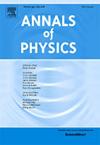通过启发式展开Nojiri-Odintsov红外截止的二阶逼近:Ricci-Gauss-Bonnet形式全息暗能量动力学的一个改进框架
IF 3
3区 物理与天体物理
Q2 PHYSICS, MULTIDISCIPLINARY
引用次数: 0
摘要
这项工作提出了Nojiri-Odintsov全息暗能量的统一处理,包括其Ricci-Gauss-Bonnet实现和二阶近似作为广义框架的特殊情况。通过引入gaus - bonnet不变量和Ricci标量的高阶曲率修正,我们构建了一个扩展的HDE模型,并研究了相互作用和非相互作用情况下状态方程参数的演化。通过宇宙天文钟和普朗克2018数据集的观测验证,分析揭示了可能的精髓到幽灵的转变。结果表明,高曲率修正的作用为后期宇宙加速提供了一个可行的描述。最后,在ricci - gass - bonnet和nojri - odintsov全息框架中,我们发现重建的wot (z)表现出desi偏好的精粹-幻影交叉,尽管普朗克和SH0ES确定的H0之间的哈勃张力仍然没有解决。本文章由计算机程序翻译,如有差异,请以英文原文为准。
Second-order approximation of Nojiri–Odintsov infrared cutoff through heuristic expansion: A refined framework for holographic dark energy dynamics with Ricci–Gauss–Bonnet form
This work presents a unified treatment of Nojiri–Odintsov holographic dark energy, encompassing its Ricci–Gauss–Bonnet realization and a second-order approximation as a particular case of the generalized framework. By incorporating higher-order curvature corrections from the Gauss–Bonnet invariant and the Ricci scalar, we construct an extended HDE model and study the evolution of the equation-of-state parameter in both interacting and non-interacting scenarios. The analysis reveals possible quintessence-to-phantom transitions, with observational validation from cosmic chronometer and Planck 2018 datasets. The outcomes indicate the role of higher-curvature corrections provide a viable description of late-time cosmic acceleration. Finally, within the Ricci–Gauss–Bonnet and Nojiri–Odintsov holographic frameworks, we find that the reconstructed exhibits the DESI-preferred quintessence–phantom crossing, although the Hubble tension between Planck and SH0ES determinations of remains unresolved.
求助全文
通过发布文献求助,成功后即可免费获取论文全文。
去求助
来源期刊

Annals of Physics
物理-物理:综合
CiteScore
5.30
自引率
3.30%
发文量
211
审稿时长
47 days
期刊介绍:
Annals of Physics presents original work in all areas of basic theoretic physics research. Ideas are developed and fully explored, and thorough treatment is given to first principles and ultimate applications. Annals of Physics emphasizes clarity and intelligibility in the articles it publishes, thus making them as accessible as possible. Readers familiar with recent developments in the field are provided with sufficient detail and background to follow the arguments and understand their significance.
The Editors of the journal cover all fields of theoretical physics. Articles published in the journal are typically longer than 20 pages.
 求助内容:
求助内容: 应助结果提醒方式:
应助结果提醒方式:


